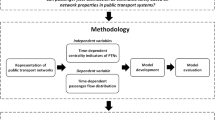Abstract
We present a mathematical model to optimize the number of output lines leaving from a transit terminal (in which passengers are supposed to split among different lines, or even change mode of transportation) and their departure times in the aperiodic case. The model is an extension to the multiple destination case of the Schedule Optimization Problem described in (Bruno et al. in OR Spectr. 31(3):465–481, 2009). The proposed model is shown to be NP-hard due to its similarities to the Multi-Item Capacitated Lot Sizing Problem. We provide computational results in order to show that the model can be used to solve instances of significant size.
Similar content being viewed by others
References
Bruno G, Improta G, Sgalambro A (2009) Models for the schedule optimization problem at a public transit terminal. IEEE Spectr 31(3):465–481
Boysen N, Fliedner M, Scholl A (2010) Scheduling inbound and outbound trucks at cross docking terminals. IEEE Spectr 32(1):135–161
Daduna JR, Voss S (1995) Practical experiences in schedule synchronization. In: Daduna JR, Branco I, Paixao JMP (eds) Computer-aided scheduling of public transport. Lecture notes in economics and mathematical systems, vol 430. Springer, Berlin, pp 39–55
Desilets A, Rousseau JM (1992) SYNCRO: a computer-assisted tool for the synchronization of transfers in public transit networks. In: Desrochers M, Rousseau JM (eds) Computer-aided scheduling of public transport. Springer, Berlin, pp 153–166
Domschke W (1989) Schedule synchronization for public transit networks. IEEE Spectr 11(1):17–24
Fischetti M, Salvagnin D, Zanette A (2009) Fast approaches to improve the robustness of a railway timetable. Transp Sci 43(3):321–335
Florian M, Lenstra JK, Rinnooy Kan AHG (1980) Deterministic production planning algorithms and complexity. Manag Sci 26(7):669–679
Klemt WD, Stemme W (1988) Schedule synchronization for public transit networks. In: Daduna JR, Wren A (eds) Computer-aided transit scheduling. Lecture notes in economics and mathematical systems, vol 308. Springer, Berlin, pp 327–335
Kroon LG, Dekker R, Vromans M (2007) Cycling railway timetabling: a stochastic optimization approach. In: Algorithmic methods for railway optimization. Lecture notes in computer science, vol 4359. Springer, Berlin, pp 41–66
Liebchen C, Möhring R (2007) The modeling power of the periodic event scheduling problem: railway timetables-and beyond. In: Algorithmic methods for railway optimization. Lecture notes in computer science, vol 4359. Springer, Berlin, pp 3–40
Liebchen C, Stiller S (2009) Delay resistant timetabling. Public Transp 1(1):55–72
Michaelis M, Schöbel A (2009) Integrating line planning, timetabling, and vehicle scheduling: a customer-oriented heuristic. Public Transp 1(1):211–232
Pochet Y, Wolsey LA (2006) Production planning by mixed integer programming. Springer, Berlin
Schmidt M, Schöbel A (2010) The complexity of integrating routing decisions in public transportation models. In: Erlebach T, Lübbecke M (eds) Proc of the 10th workshop on algorithmic approaches for transportation modelling, optimization, and systems, pp 156–169. OpenAccess series
Schroder M, Solchenbach I (2006) Optimization of transfer quality in regional public transit. Technical report, Fraunhofer, ITWM, 29
Serafini P, Ukovich W (1989) A mathematical model for periodic scheduling problems. SIAM J Discrete Math 2:550–581
Vansteenwegen P, Oudheusden D (2006) Developing railway timetables which guarantee a better service. Cent Eur J Oper Res 173:337–350
Voss S (1992) Network design formulation in schedule synchronization. In: Desrochers M, Rousseau JM (eds) Computer-aided scheduling of public transport. Springer, Berlin, pp 137–152
Wong RCW, Yuen TWY, Fung KW, Leung JMY (2008) Optimizing timetable synchronization for rail mass transit. Transp Sci 42(1):57–69
Author information
Authors and Affiliations
Corresponding author
Rights and permissions
About this article
Cite this article
Bruno, G., Genovese, A. & Sgalambro, A. An extension of the schedule optimization problem at a public transit terminal to the multiple destinations case. Public Transp 3, 189–198 (2012). https://doi.org/10.1007/s12469-011-0039-8
Published:
Issue Date:
DOI: https://doi.org/10.1007/s12469-011-0039-8




